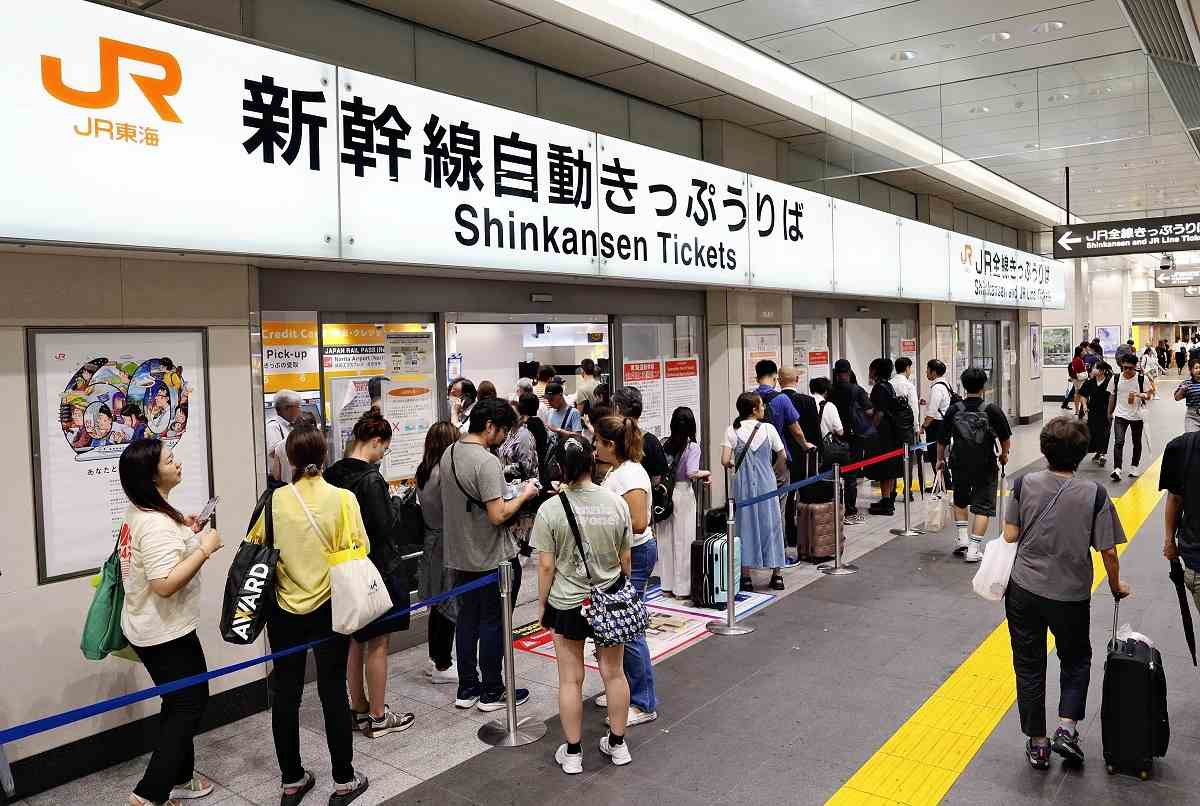Japan Train Operators Seek Best Way to Implement Planned Train Service Cancellations; Firms Began Making Announcements 10 Years Ago

Passengers gather around a ticket office for Tokaido Shinkansen bullet train services at JR Tokyo Station in Chiyoda Ward, Tokyo, on Aug. 30 after train services were canceled.
13:11 JST, September 15, 2024
Slow-moving Typhoon Shanshan, also called Typhoon No. 10, devastated many areas around the country in late August as it moved in unexpected directions, giving train operators, including Shinkansen bullet train operators, a difficult time in making decisions regarding suspensions and cancellations of services.
This year marks 10 years since planned suspensions of train services became the norm for train operators. However, companies are still wondering how to efficiently put it into practice as typhoon season continues into autumn.
Too many changes
“It was difficult to see where the typhoon was heading because the expected path kept changing every minute,” said Shunsuke Niwa, the president of Central Japan Railway Co. (JR Tokai), at a press conference on Sept. 4 explaining why the schedule for the Tokaido Shinkansen service cancellation plan changed several times.
Initially, the typhoon was expected to make landfall between the Kinki and Kanto regions, so JR Tokai and West Japan Railway Co. (JR West) services were heavily affected thereafter.
On Aug. 23, JR West announced there was a possibility that it would cancel Sanyo Shinkansen bullet train services on Aug. 27 and 28. The company subsequently changed the cancellation schedule several times, and the planned cancellations were eventually carried out on Aug. 29 and 30. Services between Hiroshima and Hakata stations were canceled for the entire day on Aug. 30.
JR Tokai also repeatedly changed its cancellation schedule. The company’s planned cancellation of Tokaido Shinkansen services was carried out from Aug. 30 through Sept. 1. It was apparently the first time in 10 years that the line’s services between Tokyo and Shin-Osaka stations were suspended for three days.
On the morning of Aug. 30, service cancellations between Tokyo and Mishima stations were hastily decided and announced before the first train. A 19-year-old German man, who was at JR Tokyo Station, looked visibly upset and said he did not know what to do.
Guidelines established
Train operators make a decision to stop train services before wind speed and rainfall reach the regulatory limits due to a typhoon or other reasons, and a planned train service cancellation is a system in which passengers are informed in advance to ensure safety and avoid disruptions.
The planned service cancellation became widely known when Typhoon Vongfong moved across the Kinki region on Oct. 13, 2014. The day before, JR West attracted a lot of attention for announcing its cancellation of all services other than its Shinkansen services in six prefectures in the Kinki region.
When Typhoon Trami hit in September 2018, East Japan Railway Co. (JR East) implemented planned service cancellations for the first time on all its services other than its Shinkansen services in the Tokyo metropolitan area. On many lines, however, the advance announcement was made only eight hours before the cancellations, leading to some disruptions still occurring.
In response, the Land, Infrastructure and Transport Ministry established guidelines, which advised train operators to make an announcement regarding the possibility of service cancellations 48 hours prior and to announce detailed information regarding the schedule of service cancellations at least 24 hours prior.
Improving track beds
JR companies are working on measures for when natural disasters occur, such as approaching typhoons.
As Tokaido Shinkansen bullet trains are known to not run well in heavy rain, JR Tokai is planning to reinforce parts of the tracks, particularly the track beds. Of all the Tokaido Shinkansen tracks, 44% are laid on track beds made of earth. It is the highest percentage among all Shinkansen lines.
When rainwater seeps into the earthen track beds, it becomes loose and unstable. If the foundation crumbles, it can lead to a buckling of the tracks, or in a worst-case scenario, derailment. JR Tokai is considering reinforcing the slopes of the track beds to improve drainage functions.
“Planned service cancellations have become accepted in society after many people experienced not being able travel as expected, either for work or vacation, during the pandemic,” said Prof. Makoto Okumura of Tohoku University’s International Research Institute of Disaster Science. “It’s important that society will become more understanding and realize that planned service cancellations are for the passenger as well.”
"Society" POPULAR ARTICLE
-

M4.9 Earthquake Hits Tokyo, Neighboring Prefectures
-

Israeli Tourists Refused Accommodation at Hotel in Japan’s Nagano Pref., Prompting Protest by Israeli Embassy and Probe by Prefecture
-

M7.5 Earthquake Hits Northern Japan; Tsunami Waves Observed in Hokkaido, Aomori and Iwate Prefectures
-

Tsukiji Market Urges Tourists to Avoid Visiting in Year-End
-

High School in Kyoto Says Students Shoplifted during Recent School Trip to Bali, Indonesia
JN ACCESS RANKING
-

Tokyo Economic Security Forum to Hold Inaugural Meeting Amid Tense Global Environment
-

Keidanren Chairman Yoshinobu Tsutsui Visits Kashiwazaki-Kariwa Nuclear Power Plant; Inspects New Emergency Safety System
-

Imports of Rare Earths from China Facing Delays, May Be Caused by Deterioration of Japan-China Relations
-

University of Tokyo Professor Discusses Japanese Economic Security in Interview Ahead of Forum
-

Japan Pulls out of Vietnam Nuclear Project, Complicating Hanoi’s Power Plans

























